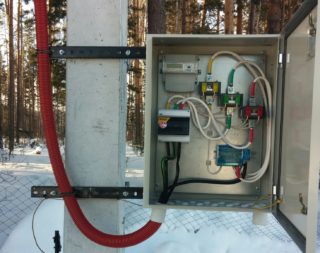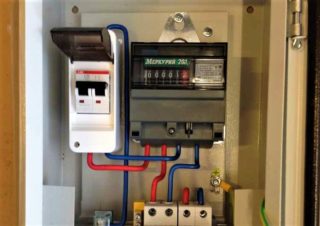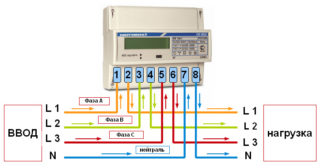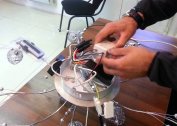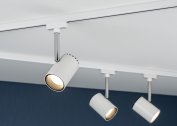Any consumer of electric energy in their relations with the supplier is guided by an agreement that details the rights and obligations of both parties. To avoid possible misunderstandings, a special recording device, called a counter, is installed at the entrance to the housing. Installation of an electric meter in a residential building or in a country house is a prerequisite for compliance with the clauses of the contract concluded between the supplier and the consumer. Before installing an electricity meter in an apartment, you must thoroughly prepare for this procedure.
Organizational activities
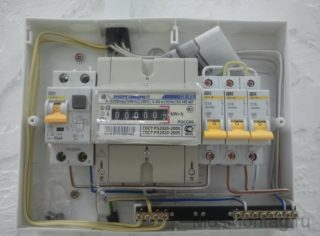
The need for work related to the installation of the meter, as a rule, arises in the following situations:
- in case of breakdown of the old device and the need to replace it with a new product;
- if you want to transfer the device from one place to another (from the corridor adjacent to the neighbors to the apartment or vice versa);
- when switching to a multi-tariff metering system for the purpose of energy conservation.
Regardless of the reasons that led to such work, each user should thoroughly prepare for them. First you need to write a statement to the supplying company with a request to install, replace or move the meter.
There may be situations when officials of Energosbyt demand to change the location of the device - to move it outside the apartment or house, for example. It is important to know that any requirements related to restrictions on its location within the premises violate the law, in which this condition is not specifically stipulated.
Further actions come down to making decisions on the following important points:
- selection of the type of meter that meets the requirements of the PUE and is suitable for specific operating conditions;
- when connecting to the power supply for the first time after approval of the application, one should obtain technical specifications for the installation of a specific model of metering device;
- if the new device is installed independently, you should worry about the invitation of a local electrician or company representative, who must confirm the correctness of its connection.
Fulfillment of the requirements for the organization of upcoming work is the most important condition for the legality of the installation of the electric meter, regardless of who it was carried out. In case of violation of at least one of the points of the requirements of the PUE - independent installation and connection of the electric meter will not be considered legitimate.
Installation requirements
Before installing an electricity meter, you will need to determine the following points:
- where it is better to install it: in the hallway, in a common corridor or on the street (the latter option is suitable only for a private house);
- how to choose a specific place in height and distance from other communications;
- which shields, cabinets or niches are suitable for its placement.
Only after solving these issues can the installation of an electricity meter in an apartment be carried out without violating the rules.
Indoor or outdoor
Before installing the electric meter, it is necessary to determine where it will be more convenient to take data on the flow from it and where it will be reliably protected from the weather. This issue is especially critical for private houses that are not equipped with automated metering systems.
In these conditions, it is customary to take electricity meters to the street, which allows meters to have access to them in the absence of owners.Installation of electronic meters in apartments has its advantages and disadvantages. In an apartment building, in particular, it is more convenient for the owner to monitor the device if it is in the hallway. On the other hand, in this case, he is fully responsible for his condition.
The line of differentiation of responsibility for accounting equipment (operational boundary) runs at the point of connection of the input power cable - to the meter. In apartments that do not have an internal distribution panel, the conditional line of responsibility runs at the location of the access niche with counters and circuit breakers mounted in it.
The choice of location and method of attachment
Compliance with the rules for installing electricity meters primarily comes down to choosing a place in which it can be installed. This is based on the following considerations:
- the device is best placed in the hallway at the entrance door, where it will be convenient for the meter to take readings or monitor the status of the device;
- when placed externally, it is mounted on the wall, in general with a corridor adjacent to the apartment, to the right or left of the front door;
- if the appliance is placed on a street in a private building, the place for it is selected taking into account the convenience of taking readings, while he himself is thoroughly insulated.
The base on which the meter is mounted must be strong and even enough. When choosing a method for fixing it, they proceed from the characteristics of the place. In standard cabinets, it is mounted on a standard din rail, and on boards and in closed niches, using dowels. Permissible deviation from the vertical - not more than 1 degree.
Installation height
This indicator is calculated based on the requirements of the EMP, which provides the following data for placement:
- installation at the level of the cabinet where the meter is installed;
- in open places (in niches or on a shield) a place under the counter is marked at a distance of 0.8-1.7 meters from the floor;
- in rooms with low ceilings, it is allowed to choose this indicator below 0.8, but not less than 0.4 meters.
In each particular case, the choice of installation height of the meter depends on the specific conditions in the place of its installation.
Overall dimensions of cases, niches, guards
In the provisions of the current norms and rules, requirements for the sizes of niches and cabinets in which the meter is mounted are not specifically stipulated. The only case where the installation is considered incorrect is the absence of sufficient gaps in the width of the cabinet walls that allow free connection wires to be connected.
The specific dimensions of cabinet structures, as well as niches and shields with a meter, depend on the density of the entire set of protective devices, including automatic devices and RCDs.
Electric meter connection
Upon completion of the installation of the device in the selected place, you should figure out how to connect the electric meter to the existing network. The sequence of operations carried out before connecting it:
- First you need to turn off the power to your home network by disconnecting the voltage with an input circuit breaker.
- Then you have to remove the cover on the panel of the meter, first removing the seal.
- Directly below it is a line of connecting terminals with a set of conductors.
- It is advisable to take the entire contact block on the photo, fixing the order of their connection.
- Then you can disconnect them and release the meter from the mounts in order to be able to install it in a new place.
If the conductors are not marked by the color of insulation, they must be tagged with numbers corresponding to the contact number on the block.
All subsequent actions are connected with the direct connection of the device to the mains. They are executed in the following order:
- A cabinet or shield is mounted at the selected location, which is then securely fixed to the wall.
- A wire harness with marked conductors of the old wiring or with a new wiring diagram, if the device is installed for the first time.
- You can begin to connect the pre-marked conductors to the numbered meter terminals.
- Care must be taken that the screw fasteners are tightened all the way.
- Upon completion of these operations, you should invite a representative of Energosbyt, who will register the installed device and seal it.
A note on the installation time is made in the passport of the electric meter, and readings are officially recorded at the time of its commissioning. Only after this it can be considered that all work has been completed, the installation of an electricity meter has been carried out legally.
Some nuances of installation
Before installing the meter at a pre-selected location, it is important to consider the following nuances.
- in case of maintenance of 380 Volt power networks, it will be necessary to purchase a three-phase device;
- if you want to install two meters at once, you will need to obtain permission from Energosbyt - usually this method of calculating electricity is not approved by representatives of the supplying organizations;
- a similar permit will have to be obtained if there is a desire to put an additional meter in a communal apartment;
- in dilapidated houses or other similar buildings, it is allowed to mount it only after a solid foundation has been prepared.
If these requirements are not observed, no representative of the supplier will register the device. The same consequences await the user if, upon independent connection, the order of switching of the lead wires was violated.
The installation of electricity meters in a private house or apartment is quite a responsible matter, requiring serious documentary evidence. This refers to such mandatory procedures as registration and sealing of the meter, as well as entering in the passport the source data.
